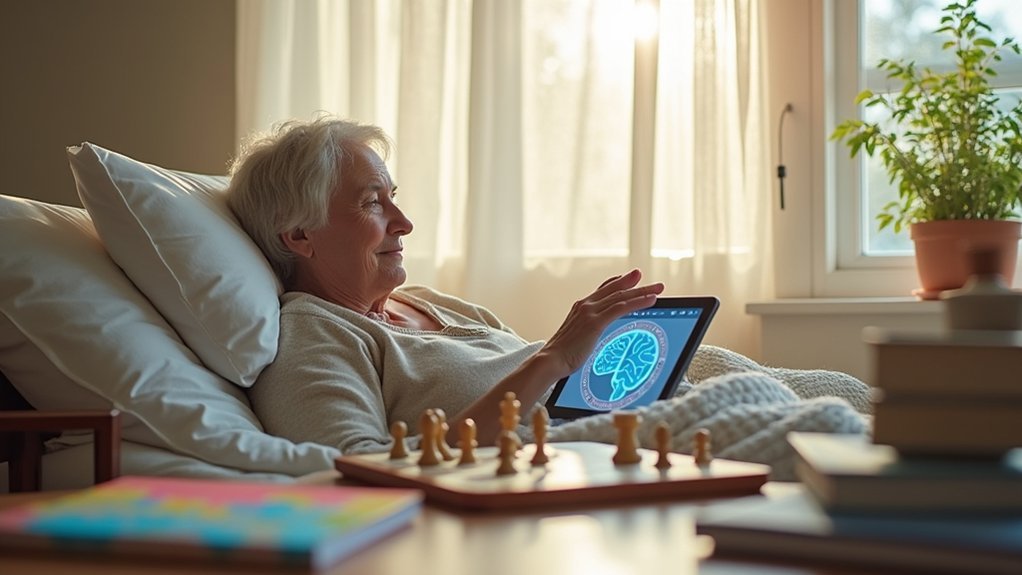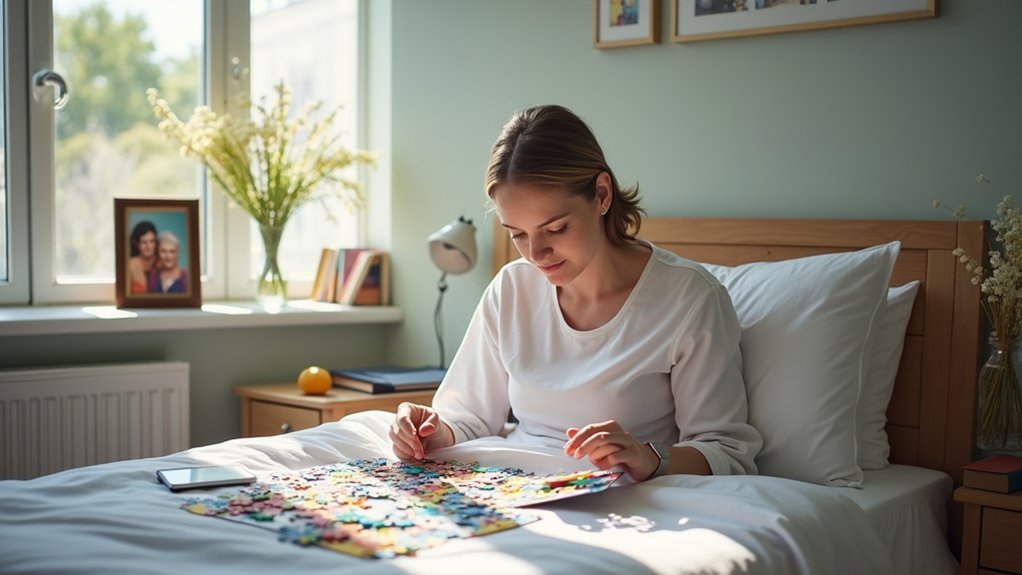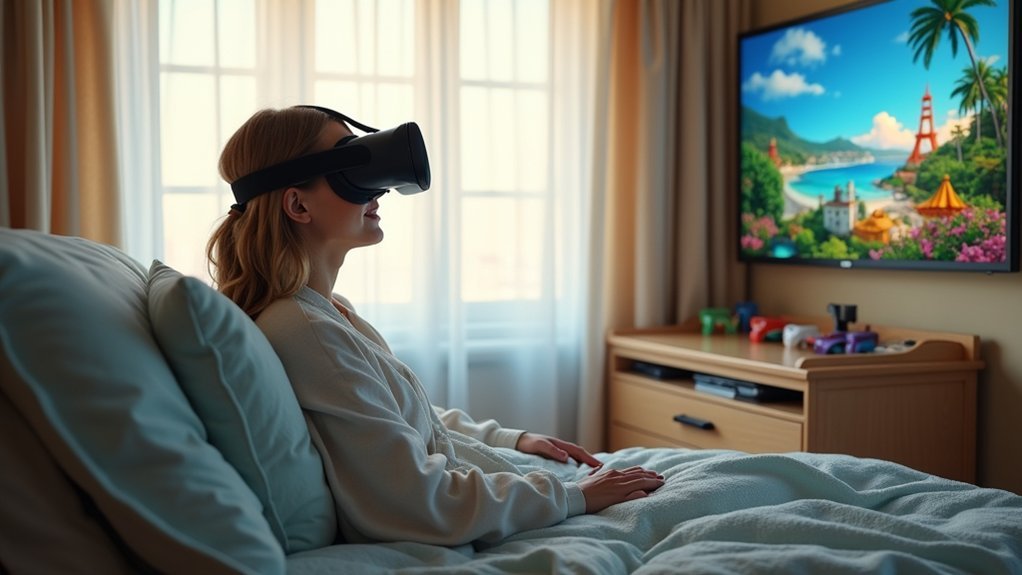Bedridden patients need daily mental challenges to preserve cognitive function and combat the silent threat of neural decline. When physical movement is limited, your brain still requires regular stimulation through puzzles, games, and creative activities. These exercises maintain neural connections, reduce anxiety and depression, and provide a sense of accomplishment. Mental engagement complements physical therapy while creating pathways similar to those activated during movement. Discover how incorporating cognitive activities into care routines can transform recovery outcomes.
Why Bedridden Patients Need Mental Challenges Daily

When the body is confined to bed, the mind often becomes the primary battleground for maintaining wellness and quality of life. Mental stimulation isn’t just beneficial—it’s essential for preserving cognitive function and emotional stability in bedridden individuals.
You’ll notice that patients who engage in regular cognitive activities experience reduced anxiety and depression, which commonly accompany prolonged bed rest. By introducing puzzles, games, and other mental challenges into your patient’s daily routine, you’re helping them maintain neural connections and potentially delay cognitive decline. Incorporating intellectually stimulating book club discussions can significantly enhance cognitive health by preventing major brain damage through regular mental exercise.
These activities provide more than just entertainment; they offer a sense of purpose and accomplishment when physical achievements are limited.
Regular mental engagement also supports better physical outcomes, improving coordination and even helping manage pain associated with immobility.
The Silent Threat of Cognitive Decline During Bed Rest
Although rarely discussed during patient care planning, prolonged bed rest poses a significant risk to cognitive function that extends well beyond physical deconditioning.
You’ll face potential declines in executive function, memory, and autonomic nervous system regulation the longer you remain immobile.
Research reveals bed rest often triggers decreased positive affect, heightened anxiety, and depression—psychological changes that further compromise cognitive health.
Your brain’s neural pathways weaken without regular stimulation, accelerating aging-related processes.
While some cognitive abilities may remain stable depending on intervention, the overall trajectory points toward decline.
The good news? Both cognitive training and exercise show promise as effective countermeasures.
Combining targeted mental stimulation with physical activity creates a powerful shield against bed rest’s hidden cognitive threats.
Scientific studies have demonstrated significant increases in reaction time during head-down bed rest, indicating measurable impairment of executive functioning.
Daily mental challenges and appropriate physical activity can help maintain your brain function despite restricted mobility, minimizing the silent cognitive deterioration that accompanies extended bed rest.
How Mental Exercises Combat Neural Atrophy

Mental exercises offer powerful defense mechanisms against the neural atrophy that threatens your brain during extended bed rest.
When you engage in cognitive tasks, you’re actively maintaining neural plasticity and stimulating the production of brain-derived neurotrophic factor (BDNF), which protects your neural health.
Cognitive training specifically targets areas vulnerable to decline, preventing the deterioration that occurs when your brain lacks stimulation.
Word games and creative writing activities help organize thoughts and enhance recall, providing crucial language skills that research shows can lower Alzheimer’s risk and delay dementia symptoms.
You’ll find computerized cognitive training (CCT) particularly effective, as it delivers long-lasting benefits even after you resume physical activity.
- Your brain craves challenges the way your body needs movement
- Every mental puzzle you solve fights invisible neural decay
- The cognitive resilience you build today protects your tomorrow’s independence
Bridging Physical Limitations With Cognitive Stimulation
While your body may be confined to bed, your mind can travel anywhere through targeted cognitive exercises.
You’ll find that mental stimulation creates neural pathways similar to those activated during physical movement, maintaining brain function despite immobility.
Engaging in regular cognitive challenges can actually complement your physical therapy and rehabilitation efforts, creating a powerful mind-body connection that transcends your current limitations.
Research indicates that cognitive stimulation activities can significantly reduce the risk of developing delirium in hospitalized patients, especially those in intensive care environments.
Beyond The Body
When physical mobility becomes severely limited, the mind can still roam freely through landscapes of thought and imagination. Your cognitive abilities don’t need to decline just because your body is confined.
Digital technology now bridges this gap, offering tablet-based therapies and accessible tools that stimulate your brain despite physical constraints. Research specifically shows that pilot studies for patients with Parkinson’s disease dementia have demonstrated improvements in mood, goal attainment, and quality of life through cognitive interventions.
Research shows cognitive stimulation during bed rest positively affects both neuroelectric activity and peripheral perfusion, creating benefits that extend beyond mental function. These brain-based interventions are designed to counteract the negative effects of inactivity.
- Feel the freedom of mental exploration when physical movement isn’t possible
- Experience the satisfaction of maintaining your cognitive abilities despite challenging circumstances
- Regain a sense of control through daily mental challenges that you can master
Mind-Movement Connection
Your brain and body share an intricate relationship that doesn’t disappear during physical confinement. When movement becomes limited, cognitive stimulation can maintain essential neural pathways involved in motor planning and coordination.
Programs that combine mental challenges with even minimal physical therapy show remarkable results in preserving motor function. This approach leverages neuroplasticity—your brain’s ability to reorganize itself—even when your body can’t move freely. Addressing the loss of self-esteem through cognitive activities helps bedridden patients regain a sense of accomplishment and purpose despite their physical limitations.
Consider the origins of Pilates, designed specifically for bedridden patients, emphasizing the mind-body connection through control and breathing exercises. These techniques demonstrate how mental engagement activates systems throughout your body.
Virtual Reality: A Window to the World for Bedridden Patients

For patients confined to their beds, virtual reality technology offers a revolutionary escape from the limitations of physical space. You can now explore mountain trails, swim in oceans, or visit museums without leaving your bed.
VR provides not just entertainment but serves as a powerful therapeutic tool, reducing pain and decreasing dependency on medication.
This technology creates meaningful mental challenges that can:
- Transport you to cherished locations from your past, triggering positive emotional memories
- Connect you with distant loved ones in shared virtual spaces, combating isolation
- Engage your mind in cognitive exercises disguised as enjoyable games and adventures
Studies show VR can achieve 24% reduction in pain after just 10 minutes of use across various types of discomfort.
VR integration with traditional therapy accelerates rehabilitation while offering a rejuvenating break from the monotony of hospital environments.
The Connection Between Mental Challenges and Mood Regulation
The profound link between cognitive engagement and emotional well-being becomes especially critical for bedridden patients facing daily psychological challenges. When you’re confined to bed, mental stimulation directly impacts your mood regulation by activating dopamine release and stabilizing your emotional responses. Research shows that individuals with limitations often experience emotional distress stemming from adverse personal histories, similar to what’s observed in people with intellectual disabilities.
| Mental Challenge | Neurological Effect | Mood Benefit |
|---|---|---|
| Puzzles & Games | Limbic activation | Reduced anxiety |
| Music therapy | Dopamine release | Elevated mood |
| Cognitive tasks | Enhanced executive function | Better emotional control |
| Social engagement | Oxytocin production | Decreased loneliness |
| Learning activities | Neural plasticity boost | Sense of accomplishment |
Without regular cognitive stimulation, you’re more vulnerable to emotional dysregulation, which can manifest as depression, irritability, or numbness. Mental challenges counteract the effects of isolation and dependency by providing purpose while simultaneously modulating stress hormones that affect your emotional stability.
Tailoring Cognitive Games to Individual Patient Needs

When designing cognitive games for bedridden patients, personalization becomes the cornerstone of effective mental stimulation. You’ll need to align challenges with their cognitive level, ensuring they feel neither overwhelmed nor bored.
Consider their personal interests to boost engagement—a history buff might enjoy historical trivia while a music lover benefits from melody-matching exercises.
Personalize cognitive challenges based on patient passions—their eyes will light up when the game speaks to their soul.
Technology offers remarkable flexibility in tailoring these experiences. With digital platforms, you can easily adjust difficulty levels as patients progress and incorporate accessibility features like voice commands for those with limited mobility. Studies show that implementing a structured game-based program can significantly improve cognitive function in adults with mild cognitive impairment.
- Watch their eyes light up when mastering a game that reflects their lifelong passions
- Feel their satisfaction when completing increasingly difficult challenges adapted to their abilities
- Experience the joy of connection when they share their progress with caregivers and loved ones
Success Stories: Cognitive Preservation in Long-Term Care
Remarkable success stories emerge daily from long-term care facilities where consistent cognitive engagement programs have made profound differences in patients’ lives. You’ll find that residents participating in structured social activities show considerably slower cognitive decline, especially those with mild or no impairment at baseline. With approximately 1.4 million people living in nursing homes nationally, implementing cognitive stimulation represents a crucial opportunity to improve quality of life for a significant population.
| Success Factor | Observed Benefit |
|---|---|
| Social conversation | Preserves reasoning abilities |
| Helping others | Maintains cognitive function |
| Structured programs | Reduces functional decline |
| Early intervention | Delays end-of-life cognitive losses |
| Combined approaches | Improves overall quality of life |
These interventions work bidirectionally – better cognition enables more social participation, which further preserves mental function. When facilities implement daily mental challenges, they’re not just filling time; they’re actively fighting against the 68% prevalence of cognitive impairment among older adults in long-term care settings.
Multisensory Stimulation: Beyond Traditional Puzzles

Moving beyond conventional cognitive exercises, multisensory stimulation offers bedridden patients a richer, more engaging approach to mental health maintenance. While traditional puzzles focus primarily on visual processing, multisensory techniques activate multiple neural pathways simultaneously, enhancing rehabilitation outcomes and cognitive function.
Extended reality (XR) technologies, including virtual and augmented reality, create immersive environments that stimulate auditory, visual, and even kinesthetic senses without requiring physical movement—perfect for those with limited mobility. These technologies can transform a sterile hospital room into a stimulating therapeutic space. Studies have shown that balancing sensory-stimulating and calming activities through Snoezelen rooms may help reduce agitation in patients with severe dementia.
- Feel the satisfaction of interacting with virtual objects when your physical world has narrowed
- Experience the joy of “visiting” cherished locations despite physical constraints
- Rediscover sensory pleasure through customized environments that awaken dormant neural connections
Integrating Mental Challenges Into Daily Care Routines
Seamlessly integrating mental exercises into daily care routines transforms what could be mundane healthcare interactions into valuable cognitive engagement opportunities.
Combine cognitive activities with physiotherapy sessions to simultaneously address both mental and physical needs while improving overall mood.
Train caregivers to recognize mental health decline signs and incorporate appropriate challenges during regular care activities.
Simple adaptations might include discussing a news article during morning care, playing word games during meals, or enjoying audiobooks during rest periods.
Personalize challenges based on the patient’s abilities and interests, creating a care model that preserves autonomy and dignity.
Research shows that activities like pegboard exercises, crosswords, puzzles, and Sudoku can significantly enhance patient alertness before physical therapy, leading to better participation and outcomes.
Establish feedback mechanisms to evaluate effectiveness—watch for improved mood, engagement levels, and cognitive responses.
Remember to adjust activities as the patient’s condition changes, ensuring continuous and appropriate stimulation.
Technology-Assisted Cognitive Training for Limited Mobility
While traditional cognitive activities remain valuable, technology now offers unprecedented options for bedridden patients to engage their minds despite physical limitations. Extended reality (XR) technologies, including virtual reality and augmented reality, create immersive environments that stimulate multiple cognitive domains simultaneously—memory, attention, and processing speed.
These technology-assisted solutions provide several key benefits:
- Liberation from physical constraints – Brain-computer interfaces and VR systems allow patients to experience movement and engagement beyond their physical reality.
- Renewed sense of agency – Customized training programs give patients control over their cognitive development when physical control is limited.
- Connection to wider worlds – Online platforms like BrainHQ offer access to communities and experiences otherwise unavailable from a hospital bed.
Research shows that immersive virtual reality environments can effectively target executive functioning in rehabilitation settings, particularly for those recovering from stroke or brain injury.
Despite cost and availability challenges, these technologies are revolutionizing cognitive care for the mobility-restricted.
Measuring Progress: Cognitive Assessment Tools for Caregivers
You’ll find several practical ways to measure your loved one’s cognitive progress, even without formal medical tools.
Simple observation techniques allow you to note changes in response time or engagement, while digital assessment apps offer structured ways to track memory and attention improvements.
Progress tracking journals create a valuable record of daily activities and achievements that can reveal subtle cognitive gains over time. For more comprehensive understanding, standardized tools like BIMS or MMSE can provide objective screening measures that help identify significant changes in cognitive functioning.
Simple Observation Techniques
Because cognitive changes often occur gradually, simple observation techniques serve as frontline tools for caregivers monitoring bedridden patients.
Watch for shifts in your loved one’s daily routines and engagement levels, documenting these changes in a caregiver diary. This consistent tracking helps identify patterns that formal assessments might miss. Early detection is critical, as over 6.7 million Americans live with Alzheimer’s disease and related cognitive impairments.
Focus on observing:
- Subtle behavioral changes like increased confusion, agitation, or withdrawal that signal cognitive shifts before they become obvious
- Changes in responsiveness during mental activities—both improvements and declines can inform your approach to stimulation
- Mood fluctuations that may indicate cognitive changes, depression, or frustration with diminishing abilities
These observations complement formal assessments and provide valuable insights when communicating with healthcare providers about your patient’s cognitive health, helping tailor mental challenges to their current capabilities.
Digital Assessment Apps
As technology continues to transform healthcare delivery, digital assessment tools have emerged as valuable resources for caregivers monitoring cognitive health in bedridden patients. These apps allow you to track cognitive changes objectively and consistently, without requiring clinical expertise. The AI-enhanced digital platform revolutionizes assessment by providing scientifically validated technology that supports early detection of cognitive impairment.
| App Type | Benefits for Bedridden Patients |
|---|---|
| Self-administered tools | Patient independence with user-friendly interfaces |
| AI-enhanced platforms | Adaptive difficulty levels for precise assessment |
| Neurocognitive testing | Customized care plans based on test outcomes |
| Mobile monitoring | Continuous assessment in naturalistic settings |
| CBT integration | Combined cognitive assessment with therapeutic intervention |
You’ll find these digital solutions particularly valuable for longitudinal tracking, enabling early detection of cognitive decline. Many integrate with electronic health records, streamlining communication between you, the patient, and healthcare providers while providing immediate feedback that traditional paper assessments cannot match.
Progress Tracking Journals
Progress tracking journals serve as invaluable tools for caregivers monitoring cognitive health in bedridden patients. They function as treasure chests of data, allowing you to observe patterns, note improvements, and identify areas needing attention over time.
By consistently documenting responses to daily mental challenges, you’ll build a thorough picture of your loved one’s cognitive journey. Consider incorporating standardized tools like Cognistat assessments that evaluate multiple cognitive domains in a relatively short timeframe.
- Watch your patient’s face light up when you show them documented improvements they’ve made over weeks or months
- Experience the relief of having concrete information to share with healthcare providers rather than relying on memory
- Feel empowered as you transform from passive observer to active participant in your loved one’s cognitive care
These journals also facilitate realistic goal-setting and help tailor cognitive activities to individual needs and preferences.
Frequently Asked Questions
How Do Family Members Participate in Cognitive Stimulation Programs?
You’ll participate by providing daily cognitive activities like puzzles and reminiscing therapy, monitoring responses, using technology-aided tools, and joining group activities. You’ll receive training to adapt exercises as cognitive abilities change.
What Are the Costs Associated With Implementing Cognitive Training Technologies?
You’ll face upfront costs for hardware, software, and staff training when implementing cognitive training technologies. However, you’ll likely see long-term savings through improved patient outcomes and reduced healthcare service needs.
Can Bedridden Patients With Severe Dementia Benefit From These Interventions?
Yes, you’ll find that bedridden patients with severe dementia can still benefit considerably from adapted interventions like multisensory stimulation, music therapy, and reminiscence activities that are tailored to their cognitive abilities and physical limitations.
How Quickly Do Cognitive Benefits Diminish if Stimulation Is Discontinued?
You’ll notice cognitive benefits diminish rapidly if stimulation stops – typically within days to weeks. Without regular mental challenges, you’re at risk for accelerated decline, especially if you’ve already experienced cognitive impairment.
Are There Insurance Coverage Options for Cognitive Preservation Therapies?
Insurance coverage for cognitive preservation therapies varies by provider. You’ll find most plans cover rehabilitation under specific codes, but you’ll need to verify your policy details and be prepared for potential denials.
In Summary
You’ve seen how critical mental challenges are for maintaining your bedridden loved one’s cognitive health. Don’t wait for decline to set in – start today with simple activities and gradually increase complexity. Whether through technology or traditional methods, you’re providing more than entertainment; you’re preserving their mental abilities. Remember, daily cognitive stimulation isn’t optional – it’s essential medicine for the mind.





Leave a Reply